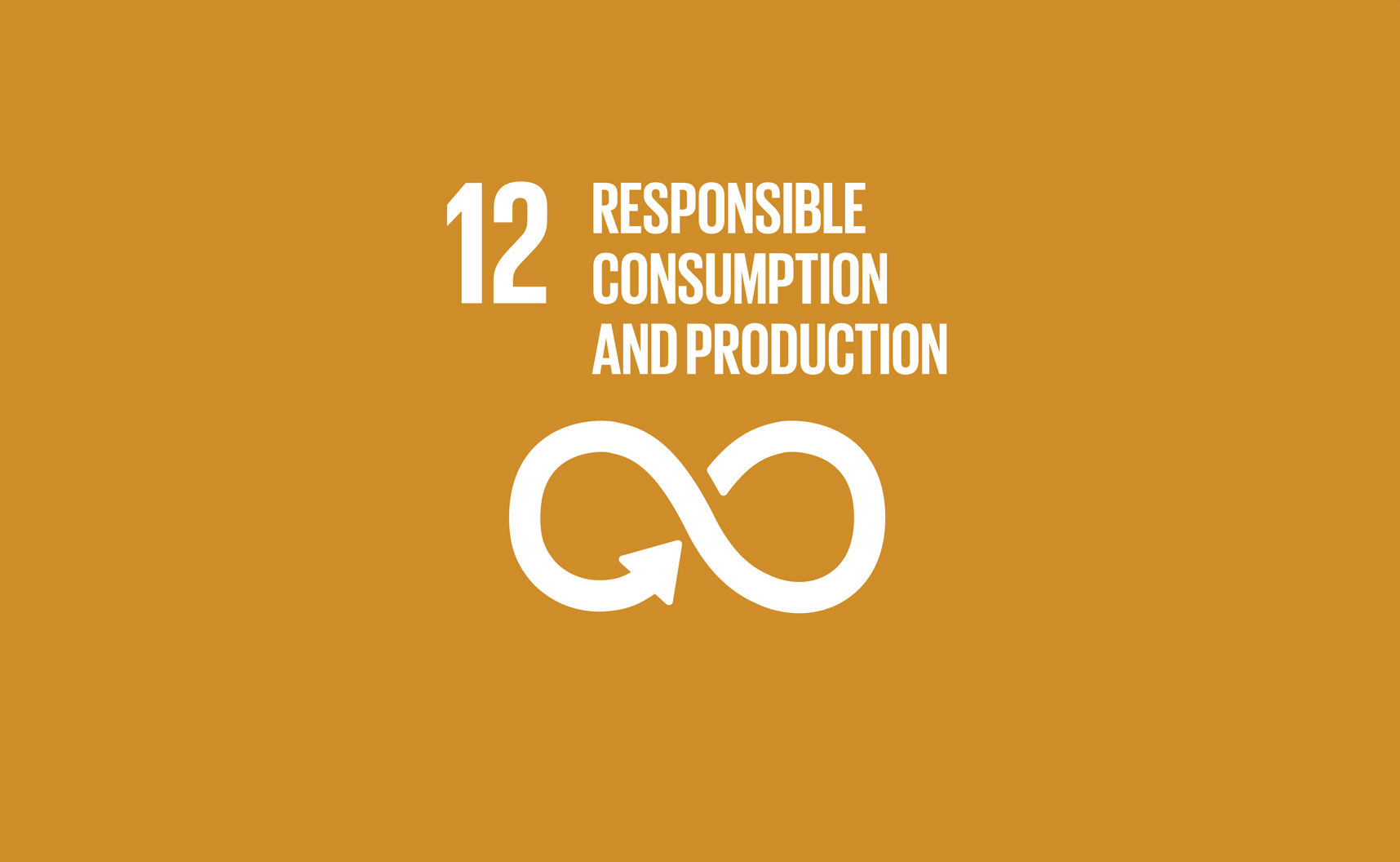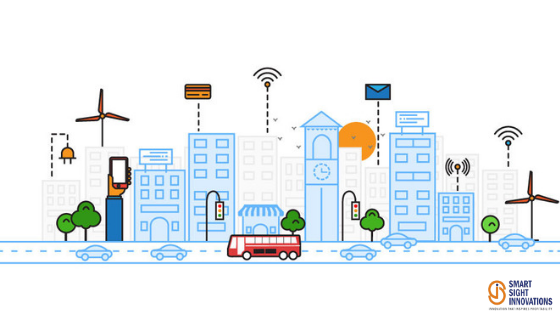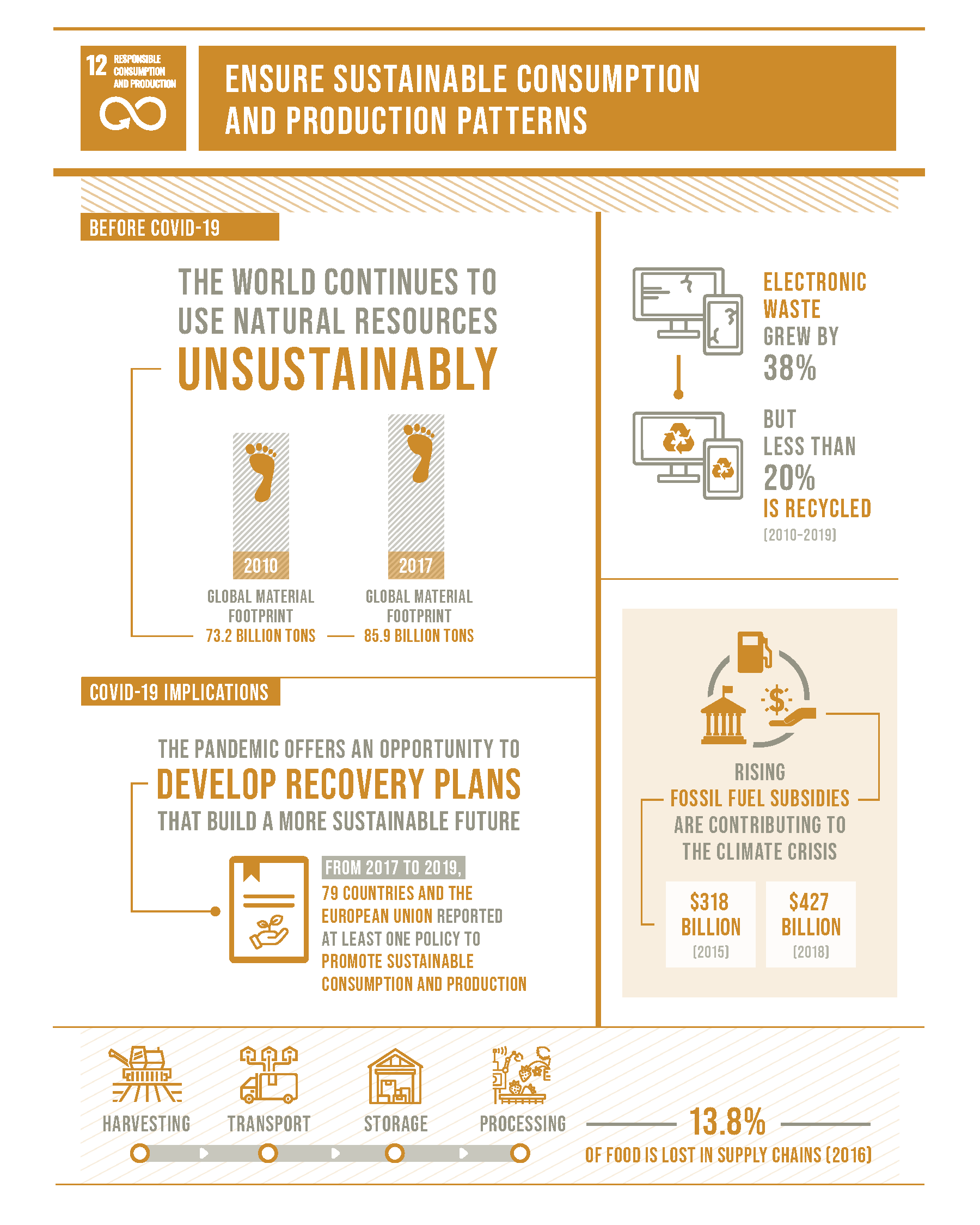Ensure sustainable consumption and production patterns is the twelfth goal of the 2030 Agenda for Sustainable Development

⠀⠀⠀⠀⠀⠀⠀⠀
Consuming our natural resources in a sustainable way sounds like an impossible goal today. Just think of Overload Day, which reveals every year the exact date on the calendar when we start to use more than the planet can provide us. Ten years ago, it was on August 18th; twenty years ago, on September 29. In 2019, we reached the worrying mark on July 29, breaking a historical record.
The fact only reinforces what scientists and environmentalists have said for decades: we need to learn how to increase and improve the quality of life in cities without destroying our planet. And the problem goes far beyond the future scarcity of resources: with exacerbated consumption, waste increases its volume and the consequent disposal and pollution further aggravate the problem.
According to the United Nations Conference on Trade and Development, there may be more plastic than fish in the oceans by 2050. According to the UN, up to 8 million tons of the material enter the sea each year. It is also worth mentioning that plastic is produced from other major pollutants, the fossil fuels: about 6% of the consumption of these non-renewable goods is currently destined for the manufacture of plastic, and this rate may reach 20% by 2050, according to the International Energy Agency.
These are just some of the alarming data that made conscious consumption and sustainable economy two mandatory topics on the agenda of many countries in the world. Calling attention to the problem, the UN did its part and addressed the issue on the 2030 Agenda for Sustainable Development, a global action plan developed to guarantee the well-being of people, cities and the planet.
Occupying the twelfth position among the 17 Sustainable Development Goals, SDG 12 – Responsible consumption and production seeks precisely to promote changes in the way we relate to the planet, defending an efficient and responsible use of all natural resources. With the mission of “ensuring sustainable production and consumption patterns“, its goals include halving global food waste per capita; achieving sustainable handling of chemicals; reducing waste generation; among others.
Achieving a more conscious consumption requires effort on the part of the population, of course, but it is also the role of cities and their respective governments to ensure that the SDG is achieved. In the case of municipalities, it is the duty of city halls to create strict agreements and laws to control pollutant emissions, to develop plans for the collection and proper disposal of urban waste, to create social programs to raise people’s awareness and to promote industrial innovation and the development of cleaner technologies.
As a smart city expert, Bright Cities knows the importance that the environment has for the construction of more sustainable, resilient and, of course, intelligent cities. In a smart city, consumption measurement is strictly controlled, as well as data about green spaces, air quality and solid waste treatment – always monitored to ensure better services to the entire population.
Moreover, a smart city knows that sustainable consumption and production is about doing more and better with less. For this reason, its urban policies seek to decouple economic growth from environmental degradation, increasing the efficiency of public services and promoting sustainable lifestyles.
When our online platform develops a diagnosis of a city, one of the ten urban areas analyzed is the environment. Based on 160 international indicators, we evaluete whether the natural resources are being properly used and preserved, and whether there are any types of damage to local ecosystems. Here, we listes some of the indicators directly related to SDG 12 – Responsible consumption and production and used by our platform:
- Indicator “Annual electricity consumption in public buildings”: with the data obtained, public administrators can analyse the public energy consumption and propose more sustainable changes, as mentioned in target 12.2 of SDG 12: “By 2030, achieve the sustainable management and efficient use of natural resources“;
- Indicator “Domestic water consumption per capita”: the data obtained with this indicator reveal whether or not there is a conscious use of water resources in the city, as stated in target 12.2 of SDG 12: “By 2030, achieve the sustainable management and efficient use of natural resources“;
- Indicator “Solid waste collection rate”: reveals the percentage of the population that has the correct disposal of solid waste, as mentioned in target 12.4 of SDG 12: “By 2020, achieve the environmentally sound management of chemicals and all wastes throughout their life cycle, in accordance with agreed international frameworks, and significantly reduce their release to air, water and soil in order to minimize their adverse impacts on human health and the environment“;
- Indicator “Percentage of recycled solid waste”: with the values obtained, public managers can know the impact of recycling policies in the city, thus being able to achieve goal 12.5 of SDG 12: “By 2030, substantially reduce waste generation through prevention, reduction, recycling and reuse“.
Based on the collection, analysis and comparison of the data obtained with these indicators, our diagnosis identifies the main challenges and creates, for each city, a personalized roadmap. In it, we point out a series of smart solutions to solve urban problems, with respective costs, deadlines and supplier indications – our platform has a database of more than 1.000 smart solutions for smart cities, the largest in the world!
By including solutions already implemented and with successful impacts in other cities, the initiatives registered on our platform offer concrete actions to face many of the urban challenges related to unrestrained consumption and waste disposal, two central issues for the SDG 12.
One of these solutions is the WASTE MANAGEMENT SYSTEM, developed by CITIBRAIN. Through the placement of sensors of low energy consumption and high durability in traditional trash containers, it is possible to maintain a tight control over the state of the container, their security and location, increasing the effectiveness and efficiency of waste management teams.

⠀⠀⠀⠀⠀⠀⠀⠀
An important fact that we must point out is about waste production is about food. According to the UN, 1.3 billion tons of food are wasted every day in the world. Included in our database, a solution aimed at solving the problem is TAIFUN, developed by MARIMATIC OY. The solution offers centralized food waste collection concept for large industrial kitchens and food courts in airports, entertainment centers, stadiums, shopping malls and marine galleys. Kitchen operators can concentrate on food production and customers, while food waste is vacuum conveyed automatically to the common waste tank from where it is easily transported for further reproduction to enhance recycling.
All over the world, this high eviction only reinforces the importance of having more intelligent solutions. According to information released by the UN, the global ecological footprint increased from 73.2 billion tons in 2010 to 85.9 billion tons in 2017, an increase of 17.4%. When we talk about electronic waste, the numbers are also alarming: from 2010 to 2019, the disposal of these products grew continuously, from 5.3 kg per capita to 7.3 kg per capita, while the environmentally friendly recycling of electronic waste increased in a slower way, from 0.8 kg per capita to 1.3 kg per capita.
The problem of product consumption and disposal is a long-standing one, to the point of making state leaders from all around the world reunite in 2012 to sign the “10-Year Framework ofProgrammeson Sustainable Consumption and Production Patterns” plan, also known as 10-YFP. The goal is “to improve international cooperation and accelerate the shift to sustainable consumption and production patterns (SCP) in developed and developing countries“.
According to the latest study released by the UN, we are still not doing our homework correctly. This is because, although recycling policies are gaining more and more strength today, we still cannot stop consuming and we are still dependent on fossil fuels. According to the information released:
- The global population is expected to reach by 9.6 billion people until 2050; the equivalent of three planets would be necessary to provide the natural resources needed to sustain today’s lifestyles;
- More than 1 billion people still do not have access to drinking water;
- If people used energy-saving light bulbs, the world would save $ 120 billion annually;
- Global fossil fuel subsidies totaled more than $ 400 billion in 2018. The continued prevalence of such subsidies, twice as much as those aimed at renewable sources, prevents the reduction of global carbon dioxide emissions;
- Global consumption of domestic material per capita increased by 7%, from 10.8 tons in 2010 to 11.7 tons in 2017, with an increase in all regions of the world – except in North America and Africa.

⠀⠀⠀⠀⠀⠀⠀⠀
With the coronavirus pandemic, a new sustainable wave that is growing in cities today offers countries the opportunity to create recovery and consumption plans that can lead us to a greener future. For the UN, the emergence of COVID-19 highlighted the relationship between people and nature and revealed the fundamental principles of the commitment we face consistently: human beings depend on the – limited – capacity of nature.
According to the organization, such a sustainable transformation could be achieved by following six fundamental steps:
- As we spend huge amounts of money to recover from the coronavirus, we must deliver new jobs and businesses through a clean, green transition.
- Where taxpayers’ money is used to rescue businesses, it needs to be tied to achieving green jobs and sustainable growth.
- Fiscal firepower must drive a shift from the grey to green economy, and make societies and people more resilient
- Public funds should be used to invest in the future, not the past, and flow to sustainable sectors and projects that help the environment and the climate. Fossil fuel subsidies must end, and polluters must start paying for their pollution.
- Climate risks and opportunities must be incorporated into the financial system as well as all aspects of public policy making and infrastructure.
- We need to work together as an international community.
Rules like these become fundamental in countries like Brazil, where the numbers reaffirm the importance of a change in urban policies. As published in the Panorama of Solid Waste in Brazil 2018/2019, a document produced by the Brazilian Association of Public Cleaning and Special Waste Companies (Abrelpe), the Brazilian population has produced more waste than the infrastructure to deal with this waste properly. In 2018 alone, there were around 79 million tons – of that amount, 6.3 million were not even collected. The survey also shows that 40.5% of the garbage was dumped in inappropriate places by more than 3 thousand municipalities.
With impacts on the economy, environment and health, the search for a more sustainable production and consumption is fundamental for building a better future, and Bright Cities has the ideal solution to help cities face these urban challenges. Always working in partnership with mayors and public bodies, we evaluate and encourage concrete actions towards the goals of the SDGs.
To learn more about our work, check out the special content we have prepared about the platform. Contact us and find out how we can make your city smarter!



